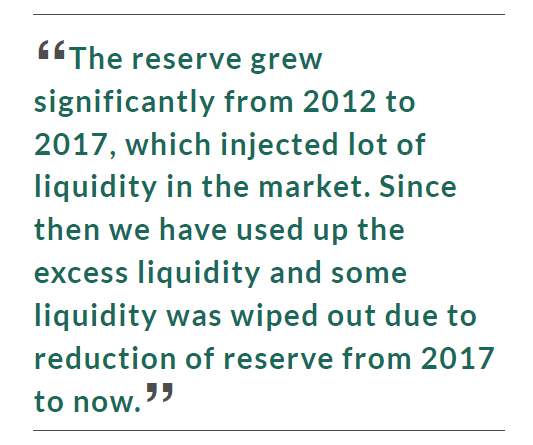MD. Shaheen Iqbal Head of Treasury, BRAC Bank Ltd.


Md. Shaheen Iqbal is currently serving as the Head of Treasury and Financial Institutions of BRAC Bank Limited. He joined BRAC Bank Limited in March 2004 and prior to his current role, he performed the role of Head of Asset Liability Management and Banking Institutions in BRAC Bank Limited. MBR had the opportunity to have an interview session with him on the current liquidity scenario of Bangladesh.
MBR: Please opine on the current liquidity scenario in Bangladesh?
MD. Shaheen Iqbal:
If we look at the major indicators like deposit growth and credit growth, there is a huge gap between them. Right now in Bangladesh, credit growth is much higher than the deposit growth, which should be ideally the other way around or at least matching each other creating an equilibrium. When deposit growth is smaller than credit growth, it is natural to feel the liquidity pressure. Last year when the liquidity pressure was building up , Central Bank reduced the CRR to minimize the liquidity pressure in the banking sector. The effect of that policy decision has come to an end and now again the Banking sector is facing the current liquidity situation. Furthermore, we can see that M2 over private sector credit growth is at a multi period high. This is another sign which indicates there is liquidity –pressure right now in the market.
MBR: What are the reasons of liquidity crisis?
MD. Shaheen Iqbal:
As I said there are two key factors here: credit growth and deposit growth. The main ways by which savings is channeled can be either through bank deposit or through the national saving certificate. Now a significant portion of the fund is channeled through national savings certificate due to higher interest rate which makes the bank deposits unattractive. This is the reason for the current situation.
MBR: What can be the impact of this situation on the private sector credit growth?
MD. Shaheen Iqbal:
The impact is that the private sector is being crowded out. Since, banks are getting less deposits compared to the demand for credit,banks right now have less money to lend, which either leads to less availability of funds to lend to the private sector or makes the interest rate higher.

MBR: How current liquidity situation will impact on the major economic indicators like growth, inflation, savings, etc.?
MD. Shaheen Iqbal:
As a result of this situation, savings will be encouraged as interest is getting higher. But if we consider the private sector, with such high interest rates, fewer projects will be viable for the companies to carry on as a result of the requirement of higher IRR. Export will become less competitive as exporters cost of doing business will be higher due to the higher interest rate. It might curb inflation a little bit, but the other indicators are showing that inflation will not be much of a challenge at this point of time. A In the end, the current liquidity situation will heavily impact the overall growth, cutting down the growth rate and overall demand.
MBR: According to the media report, banks are now offering higher interest rates to attract the depositors, how this situation is likely to impact the capital market?
MD. Shaheen Iqbal:
If the risk-free rate is high, or in other word if the fixed income earnings for the depositors become high, they will obviously move away from capital market. This is even backed by a fundamental theory of finance that, if long term bond offers a better return, than people will move out of the capital market. This is applicable even for any short term security. If the rate is high, why will the average investors take risk of the capital market when they can get assured return from these securities? An average individual will always prefer the less risky path, and avoid the high-risk options.

MBR: What is the expectation from the capital market if this scenario continues down the line?
MD. Shaheen Iqbal:
What we sorely lack in our capital market is that there are very few fundamentally driven stock investors in our market. We need more AMCs, professional investors, and money managers in our capital market. Only that can ensure the proper behavior of the capital market. The current price level of stocks is logical and attractive for the investors. Thus, it should attract more investors gradually.
MBR: How is the external sector of Bangladesh is performing now?
MD. Shaheen Iqbal:
Compared to last year, the external sector of Bangladesh is performing really well. All the indicators are reflecting this. We have achieved a better balance this year. The negative figure in the current account is improving gradually andwe have reduced the export-import gap significantly. Import growth is now negative, export & remittance growth is positive, and FDI has increased. Altogether I can say external sector has improved significantly.
MBR: How do you think the local liquidity scenario will create an impact on the external sector?
MD. Shaheen Iqbal: A major challenge which will arise from the issue is for the exporters, as the interest rate is increasing the cost of borrowing for the exporters is increasing along with it. But if we can adjust the effect of higher interest rate with flexibility in exchange rate, we can overcome or nullify the impact of liquidity pressure.
MBR: What should be the steps for the regulators or stakeholders to address the scenario of liquidity scenario?
MD. Shaheen Iqbal:
Regulatory bodies first need to set the target about what the interest rate will be. Then they might inject money in the market accordingly to achieve the target. They can offer term REPO, and again cut down CRR and SLR to address this scenario. The regulators can inject liquidity by buying long term securities as well. Furthermore, as inflation is not an issue now, the tools that are available for the regulators are enough to keep the rate in control. However, with proper policy implementation, it is possible to make the transition smoother.
Monthly Business Review- May 2019
During July-February of FY 2018-19, the net sale of National Savings Certificate (NSC) exceeded the target for the entire fiscal by 35%, already BDT 5,602.49 crore worth of NSCs sold against the target of BDT 26,197 crore. Deposit mobilization for the same period registered only 9.6% average growth. On the other hand, according to media reports, USD sale by Central Bank increased to a greater extent, to the tune of USD 1.87 billion in July to March of FY2018-19, whereas BDT 84 for USD 1 sale is being withdrawn from banking system.
Central Bank already took measures to address the liquidity situation, for instance, reducing the Cash Reserve Ratio (CRR) to 5.5%. However, sale of NSCs can only be ensured to those in need of social safety net. Also, it is high time Government should focus on money market (banking system) and capital market (bond) as alternative source of funding.
Download View